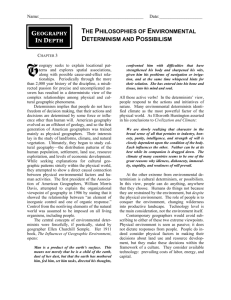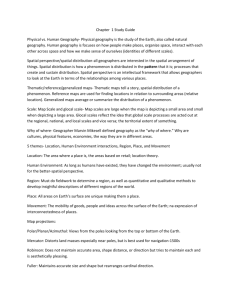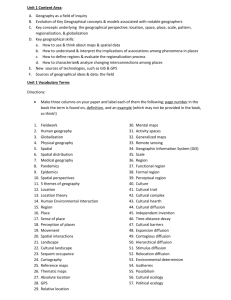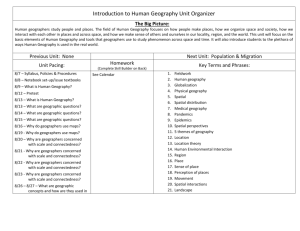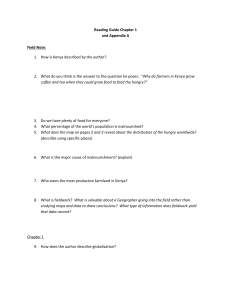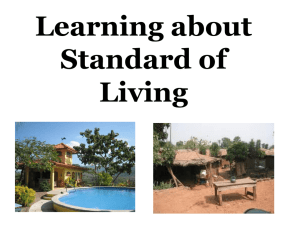Key-Issue-2-Regions - Martin`s AP Human Geography
advertisement
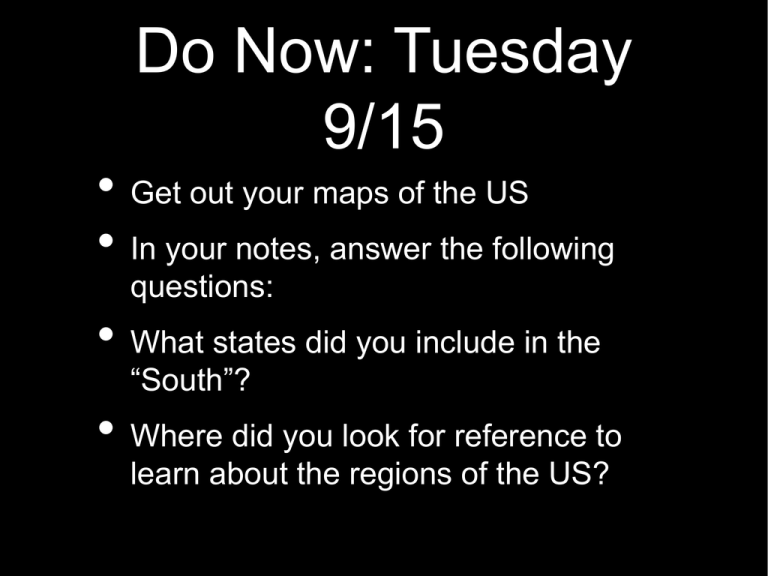
Do Now: Tuesday 9/15 • Get out your maps of the US • In your notes, answer the following questions: • What states did you include in the “South”? • Where did you look for reference to learn about the regions of the US? “The South”? “The South”? “SoutheastXSouthwest ”? “The South” • Here is one list. • Here is another. • Here is one more. • Why are there different ideas of what states should be included in “The South”? Objective: • We will be able to identify characteristics and types of regions • We will discuss why geographers group places together into regions in order to better study places Regions • generally defined as an area larger than a city that contains unifying social and physical characteristics • Regions are not well-defined units; rather, they are conceptual constructions that geographers use for comparison and convenience Regions • could be as small as a neighborhood, or all of Western Europe • usually composed of several neighboring countries that share important features • could be based off of physical characteristics, climate, or cultural characteristics such as language or religion. Regions Cont’d • • Test Tip: don’t think of regions as just places, but as processes. Regions change throughout time. Example: 18th Century, European colonists referred to the “American West” as including upstate NY and Kentucky. By the early 19th Century, the “American West” referred to the region that we call the “Midwest”. By the late 19th Century, “American West” meant the Rocky Mountains, Great Basin, and the Pacific Coast. P.S. Need to Know... • Pattison - Regional Studies Tradition • Carl Sauer & Robert Platt 3 Types of Regions • Formal Region • Functional Region • Vernacular Region Formal Region • AkA: uniform region or homogeneous region • : an area within which everyone shares in common one or more distinctive characteristics. (ie. cultural value (language), economic activity (crop), environmental property (climate) Formal Regions 2 • Example: Countries or local government units are formal regions • Example: Region where wheat is the most commonly grown crop • Example: Predominantly vote Republican or Democrat What to remember: • Is any region really homogeneous? • No. • There are always minorities that differ from the characteristic. •2004 Election Results: Kerry received 48% of the votes, but he only one 1/6th of the country’s land area (including big cities) •Did each red state actually vote 100% for either B or K? • Bush won 60% of the rural vote, Kerry won 60% of the city vote Functional Region • AkA: nodal region • region organized around a node or focal point • region relates to the central focal point (node) by transportation or communications or by economic associations Example: San Francisco Bay Area • How is this a functional region? • What is the central focal point of this region? • Hint: What is the economic relationship between the area and San Francisco the city? Vernacular Regions • AkA: perceptual region • a region that people believe exist as a part of their cultural identity • these regions represent peoples’ informal sense of place rather than a scientific model that can be geographically demonstrated Vernacular Regions • Peoples’ attachment to the region that they perceive as their home is what geographers call a “sense of place” • Can you think of any other examples of vernacular regions? Regions Review • What are regions? • For what purpose do geographers create regions? • What are the 3 types of regions? • How are these regions organized? Do Now: Tuesday 9/29 • Pick up the Regions FRQ Answer Guide • As you get your essay, read it over in comparison to the answer guide. Note which points you could have included, and which aspects of regions are still unclear. • Be prepared to share your findings. What kind of region? ` Spatial Association of Regions • Regions can be based on varying scales form large to small • Based on the scale of a region, very different conclusions can be reached • Example: number of Americans that die of cancer each year. Spatial Associations • How do geographers use maps showing cancer death rates? • To explain why a region has a high cancer death rate, geographers try to identify cultural, economic, and environmental factors that display similar spatial distribution. • Factors w/ similar distribution have a spatial association w/ cancer deaths • By applying spatial perspective, geographers can identify factors related to cancer deaths Based on this map, which region has the highest cancer rate? Why do you think they might have the highest cancer death rate? • spatial association: NE states distribution of cancer associated with distribution of factories? SE - lower education and income? Which counties in MD have the highest cancer rates? • Spatial Association at state scale: Balto City higher % of people w/ low income and education? Eastern Shore exposed to runoff chemicals that farms dump in Chesapeake Bay? Which neighborhoods in Baltimore have the highest cancer rate? • • What factors influence cancer death rates in Baltimore City? Southern counties closer to factories? Could it be something else? • How could you apply this example to the spatial perspective FRQ? Cultural Landscape • this is what gives a region its unified character • combination of traits: cultural - language and religion, economic agriculture and industry, physical - climate and vegetation Types of Data • • • Quantitative Data - uses rigorous mathematical techniques to develop numerical data that can be analyzed to demonstrate relationships Important in economic, political, and population geography Example: Macau is the most densely populated region on earth, with 47,728/sq mi Quantitative Data • In your notes, write down an example of Quantitative Data that one could collect regarding the great city of Baltimore..... Types of Data • • Qualitative Data - 'Soft' data that approximates but does not measure attributes Information associated with cultural or regional geography b/c it tends to be more unique to and descriptive of a particular place. • Example: Macau’s unique mixture of Chinese and Portuguese traditions makes for interesting restaurants that tourists love to visit Qualitative Data • In your notes, write down an example of Qualitative Data that one could collect regarding the great city of Baltimore..... Other types of Data • Idiographic - facts or features that are unique to a particular place or region, such as its history or ethnic composition • Nomothetic - concepts that are universally applicable, such as erosion processes, or the impacts of industrialization on populations. Cultural Ecology • • • • What is cultural ecology? : the geographic study of human-environment relationships Humboldt and Ritter Which Geography theme does this apply to? Pattison’s traditions? Pattison’s Man-Land everybody! Example: Cultural Ecology • Why do we grow grass in our front yards, making more work to water it, mow it, and impose fines on people that let it grow too tall? • What concept is this an example of? Environmental Determinism • The belief that cultural traits are formed and controlled by environmental conditions. • Certain cultures from certain environments may be smarter, more attractive, or more able to govern themselves Environmental Determinism • Not a popular or politically correct theory in geography. • Contains racist implications • Used by European colonists to justify colonizing the world Guns Germs & Steel • Could someone summarize Dr. Jared Diamond’s argument in Guns Germs & Steel? • Is his argument/theory based on environmental determinism? Why / Why not? “I may have a combover, but I’m not racist” Possibilism • environment may set some restraints, but culture is determined by mans’ actions • : different environmental conditions offer both restraints and opportunities to people living in various regions. Possibilism • • • • Cultures in more developed parts of the world develop ways to counteract environmental limitations Example: cars with 4 wheel drive Example: new types of technology to create energy Cultures in less developed regions may be more restrained by their environments Which is it? • • Environmental Determinism - is culture primarily determined by where one lives? Possibilism - can people adjust to their environment, and utilize their resources to create a culture that is their creation?

